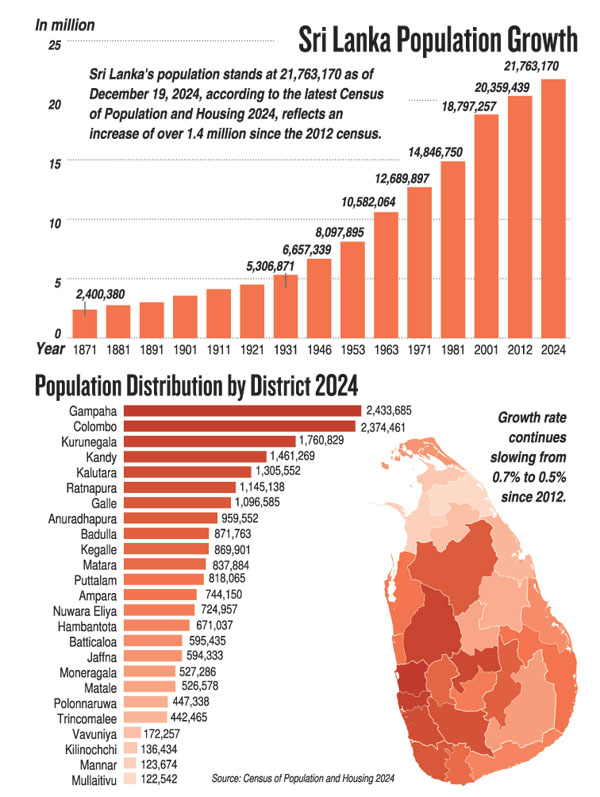News
Sri Lanka’s population increasing at a slower rate, 2024 census shows
View(s):Sri Lanka’s population is gradually increasing, though at a slower pace, the Census and Statistics Department has revealed.
The Department, which completed the Census of population and Housing-2024, in its findings released this week said the annual average growth rate has been comparatively reducing,
Accordingly, the population growth rate, which was 0.7 percent at the time of the 2012 census, has decreased to 0.5 percent in the 2024 census.

Reasons for the decrease in the population growth rate of a country include low fertility rates, long-term low birth rates, high death rates, increased migration out of the country, widespread diseases, epidemics and war situations during the relevant period.
The highest average annual growth rate of the population in the last 153 years, 2.8 percent, was recorded in the 1953 census.
The population in Sri Lanka was 2,400,380 at the first census conducted in 1871.
The population was reported as 12,689,897 at the 1971 census, which took place a 100 years after the first census, and 21,763,170 at the 2024 census, conducted 53 years after the 1971 census.
Of this population, 2,281 persons are roofless and live without a place of usual residence.
This census has shown an increase of 1,403,731 compared to the population reported in the Census of Population and Housing 2012.
When considering the population by province in Sri Lanka, the Western Province has the highest population, accounting for 28.1 percent of the total, while the Northern Province has the lowest, with 5.3 percent of the total population.
In the population distribution at the district level, Gampaha District has reported the highest, with 2,433,685 persons. Colombo District follows, with a population of 2,374,461. Together, only these two districts have a population of over 2 million.
Apart from Gampaha and Colombo districts, the highest population is reported from Kurunegala (1,760,829), Kandy (1,461,269), Kalutara (1,305,552), Ratnapura (1,145,138), and Galle (1,096,585) districts respectively, with each of these districts reporting a population of more than one million.
As in the previous censuses, districts with the lowest population in the country this time are Mullaitivu (122,542), Mannar (123,674), Kilinochchi (136,434) and Vavuniya (172,257) districts in the Northern Province.
The highest annual growth rate of 2.23 percent has been reported from Mullaitivu district. The lowest annual growth rate is recorded in Vavuniya District (0.01 percent).
As in previous censuses, the highest population density of 3,549 persons per square kilometre is reported in Colombo District, while the lowest population density is reported in Mullaitivu District, which has a population density of 50 persons per square kilometre.
The best way to say that you found the home of your dreams is by finding it on Hitad.lk. We have listings for apartments for sale or rent in Sri Lanka, no matter what locale you're looking for! Whether you live in Colombo, Galle, Kandy, Matara, Jaffna and more - we've got them all!

